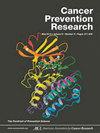Editors' Selections from Relevant Scientific Publications
IF 2.9
3区 医学
Q2 ONCOLOGY
引用次数: 0
Abstract
Highlights from the Literature| June 01 2023 Editors' Selections from Relevant Scientific Publications Author & Article Information Online ISSN: 1940-6215 Print ISSN: 1940-6207 ©2023 American Association for Cancer Research2023American Association for Cancer Research Cancer Prev Res (Phila) (2023) 16 (6): 303. https://doi.org/10.1158/1940-6207.CAPR-16-6-HFL Views Icon Views Article contents Figures & tables Video Audio Supplementary Data Peer Review Share Icon Share Facebook Twitter LinkedIn Email Tools Icon Tools Get Permissions Cite Icon Cite Search Site Article Versions Icon Versions Version of Record June 1 2023 Citation Editors' Selections from Relevant Scientific Publications. Cancer Prev Res (Phila) 1 June 2023; 16 (6): 303. https://doi.org/10.1158/1940-6207.CAPR-16-6-HFL Download citation file: Ris (Zotero) Reference Manager EasyBib Bookends Mendeley Papers EndNote RefWorks BibTex toolbar search Search Dropdown Menu toolbar search search input Search input auto suggest Search Advanced Search Obese adipose tissue in the mammary gland (by Arendt et al. via Cancer Research Bhardwaj et al. investigated whether high body mass index (BMI) increases breast cancer risks for women carrying BRCA 1 or BRCA2 mutations. They examined noncancerous breast tissue from 69 such women and found that BMI and biomarkers of metabolic dysfunction were positively correlated with DNA damage in epithelia. RNA sequencing data revealed that obesity altered breast adipose microenvironment and activated estrogen biosynthesis. Blocking signaling pathways mediated by either estrogen or obesity-associated factors leptin or insulin, reduced DNA damage. Additionally, a high-fat diet increased DNA damage and mammary tumors in Brca1+/−mice. These results provide mechanistic insight linking obesity and breast cancer in BRCA mutation carriers, and suggest that reducing risk may involve maintaining a lower body weight, addressing metabolic problems and targeting estrogen. Bhardwaj P, … Brown KA. Sci Transl Med. 2023 Feb 22;15(684):eade1857.... You do not currently have access to this content.编辑对相关科学出版物的选择
文献摘录2023年6月1日编辑精选相关科学出版物作者和文章信息在线ISSN: 1940-6215印刷ISSN: 1940-6207©2023美国癌症研究协会2023美国癌症研究协会癌症预防研究(费城)(2023)16(6):303。https://doi.org/10.1158/1940-6207.CAPR-16-6-HFL查看图标查看文章内容图表和表格视频音频补充数据同行评审共享图标共享Facebook Twitter LinkedIn电子邮件工具图标工具获得权限引用图标引用搜索网站文章版本图标版本记录版本2023年6月1日引文编辑从相关科学出版物的选择。癌症预防中心(费城)2023年6月1日;16(6): 303。https://doi.org/10.1158/1940-6207.CAPR-16-6-HFL下载引文文件:Ris (Zotero) Reference Manager EasyBib Bookends Mendeley Papers EndNote RefWorks BibTex工具栏搜索搜索下拉菜单工具栏搜索搜索输入搜索输入自动建议搜索高级搜索乳腺中的肥胖脂肪组织(由Arendt等人通过Cancer Research) Bhardwaj等人研究了高体重指数(BMI)是否会增加携带BRCA 1或BRCA2突变的女性患乳腺癌的风险。他们检查了69名女性的非癌性乳腺组织,发现BMI和代谢功能障碍的生物标志物与上皮细胞的DNA损伤呈正相关。RNA测序数据显示,肥胖改变了乳房脂肪微环境,激活了雌激素的生物合成。阻断由雌激素或肥胖相关因子瘦素或胰岛素介导的信号通路,减少DNA损伤。此外,高脂肪饮食增加了Brca1+/−小鼠的DNA损伤和乳腺肿瘤。这些结果为BRCA突变携带者的肥胖和乳腺癌之间的联系提供了机制见解,并表明降低风险可能涉及保持较低的体重,解决代谢问题和靶向雌激素。Bhardwaj P, Brown KA。科学转化医学。2023 Feb 22;15(684):eade1857....您目前没有访问此内容的权限。
本文章由计算机程序翻译,如有差异,请以英文原文为准。
求助全文
约1分钟内获得全文
求助全文
来源期刊

Cancer Prevention Research
医学-肿瘤学
CiteScore
6.00
自引率
3.00%
发文量
173
审稿时长
1 months
期刊介绍:
Cancer Prevention Research publishes original studies, reviews, and perspectives in the field of cancer prevention. Its scope includes the molecular and cellular biology of premalignancy and early lesions; genetic and environmental risk factors; risk assessment and reduction; early detection research (cancer screening and diagnosis); and preventive interventions (chemoprevention, immunoprevention, and others) to intercept cancer development at early stages prior to initiation, promotion, or progression. The journal comprises preclinical, clinical, and translational research, with special attention given to molecular discoveries and an emphasis on building a translational bridge between the basic and clinical sciences.
 求助内容:
求助内容: 应助结果提醒方式:
应助结果提醒方式:


